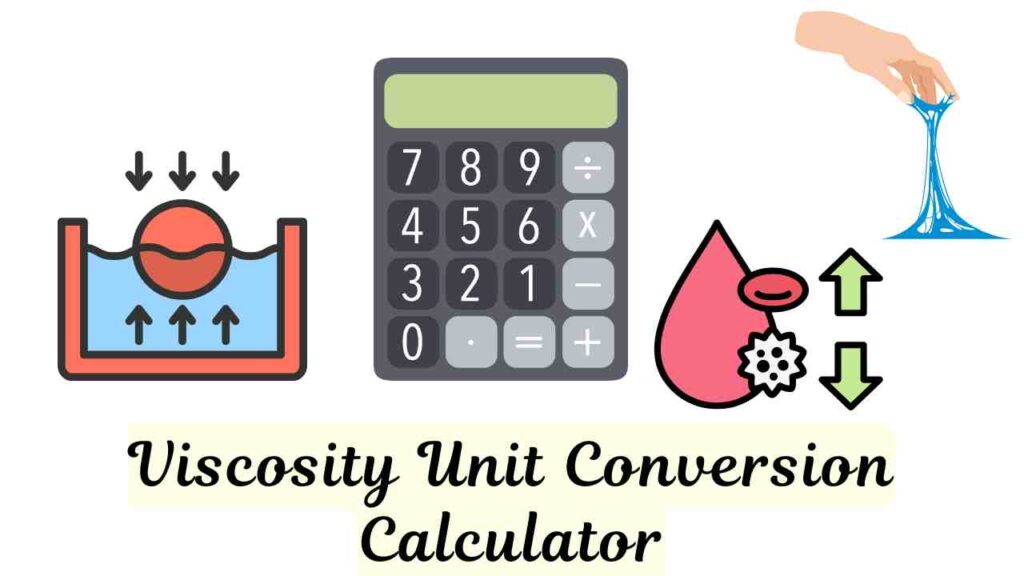Viscosity is a fundamental property of fluids that measures their resistance to flow. Whether you’re working in chemical engineering, fluid dynamics, or material science, understanding and converting between viscosity units is essential for accurate calculations and effective communication across disciplines. However, switching between units like Poise (P), Centipoise (cP), Pascal Seconds (Pa·s), and Stokes (St) can be challenging without the right tools.
Viscosity Unit Converter
To simplify this process, we’ve developed a free, intuitive online Viscosity Unit Conversion Calculator that allows you to convert between any viscosity units instantly. In this blog post, we’ll explore why viscosity conversions matter, common scenarios where they’re needed, and how this calculator can help you work smarter.
Viscosity Unit Conversion Calculator
Table of Contents
Viscosity plays a critical role in determining how fluids behave under different conditions. It influences everything from the flow of oil in pipelines to the consistency of paints and coatings. The most commonly used viscosity units include:
- Poise (P) : A CGS unit of dynamic viscosity, often used in scientific contexts.
- Centipoise (cP) : A smaller unit equivalent to 0.01 Poise, widely used in industrial applications (e.g., water has a viscosity of ~1 cP at room temperature).
- Pascal Second (Pa·s) : The SI unit of dynamic viscosity, equal to 10 Poise.
- Millipascal Second (mPa·s) : A smaller SI unit, equivalent to 0.01 Poise.
- Kilogram per Meter Second (kg/(m·s)) : Another SI unit, numerically equivalent to Pascal Seconds.
- Stokes (St) : A CGS unit of kinematic viscosity, used in fluid dynamics.
- Centistokes (cSt) : A smaller unit of kinematic viscosity, widely used in industries like oil and gas.
Each unit serves a specific purpose, and converting between them ensures consistency and accuracy in calculations.
Why Convert Viscosity Units?
Converting between viscosity units is crucial for several reasons:
- Cross-Disciplinary Work : Different fields use different units. For example, engineers might work in Pascal Seconds, while chemists prefer Centipoise.
- Precision in Measurements : High-precision applications, such as lubricant design or polymer processing, require accurate conversions between units.
- Compatibility : When integrating systems or tools that use different units, conversions ensure seamless operation.
- Education and Research : Students and researchers often need to compare data across multiple scales, making unit conversions indispensable.
- Real-World Applications : From assessing oil viscosity to optimizing industrial processes, unit conversions play a vital role in countless industries.
Introducing the Viscosity Unit Conversion Calculator
To simplify the process of converting viscosity units, we’ve developed a free, easy-to-use online Viscosity Unit Conversion Calculator . This tool allows you to convert between any two units instantly while also providing a comprehensive list of all possible conversions for your input value.
How It Works
- Enter the Value : Input the numerical value you want to convert.
- Select "From" and "To" Units : Choose the unit you’re converting from (e.g., Centipoise) and the unit you’re converting to (e.g., Pascal Seconds).
- Click "Convert" : The calculator will display the converted result for your selected "to" unit.
- View All Conversions : Below the main result, you’ll find a grid showing the equivalent values in all supported units, giving you a complete overview.
Example Conversion
Let’s say you have a fluid with a viscosity of 100 Centipoise (cP) and need to determine its value in Pascal Seconds:
- Enter
100in the input field. - Select "Centipoise (cP)" as the "from" unit and "Pascal Second (Pa·s)" as the "to" unit.
- Click "Convert."
The calculator will show:
- Main Result :
100 Centipoise (cP) = 1 Pascal Second (Pa·s) - All Results Grid : Poise (P): 1Centipoise (cP): 100Pascal Second (Pa·s): 1Millipascal Second (mPa·s): 1000Kilogram per Meter Second (kg/(m·s)): 1Stokes (St): 10Centistokes (cSt): 1000
This instant overview saves time and ensures accuracy in your calculations.
Key Features of the Calculator

- Dynamic Dropdowns : Automatically populated with all supported units for quick selection.
- Responsive Design : Works seamlessly on desktops, tablets, and mobile devices.
- Scientific Precision : Handles large and small numbers with ease, displaying results in either standard or scientific notation.
- Comprehensive Results : Provides not just the specific conversion but also a full breakdown of all equivalent values.
- User-Friendly Interface : Clean, intuitive design with hover effects for better readability.
Practical Applications of the Calculator
Here are some real-world scenarios where this calculator can be invaluable:
- Chemical Engineering : Convert centipoise to pascal seconds when designing reactors or pipelines.
- Oil and Gas Industry : Translate centistokes into stokes for pipeline flow optimization.
- Material Science : Switch between poise and millipascal seconds when analyzing polymer viscosity.
- Food and Beverage Industry : Measure viscosity in centipoise for quality control of sauces, syrups, and other liquids.
- Education : Help students understand the relationships between different viscosity units through hands-on exploration.
Tips for Using the Calculator Effectively
- Double-Check Inputs : Ensure the value and units you enter are correct to avoid errors.
- Understand Context : Know which unit is most appropriate for your application before performing conversions.
- Explore All Results : Use the "All Results" grid to gain insights into how different units compare.
- Bookmark the Tool : Save the calculator link for quick access whenever you need it.
Conclusion
Understanding viscosity units and their conversions is a critical skill in many fields, from chemical engineering and fluid dynamics to material science and food production. With our Viscosity Unit Conversion Calculator , you can streamline this process and focus on what truly matters—your work. Whether you’re optimizing industrial processes, studying fluid behavior, or solving complex problems in physics, this tool empowers you to handle viscosity conversions with confidence and precision.